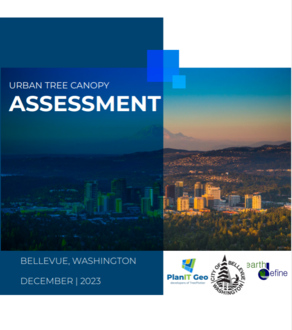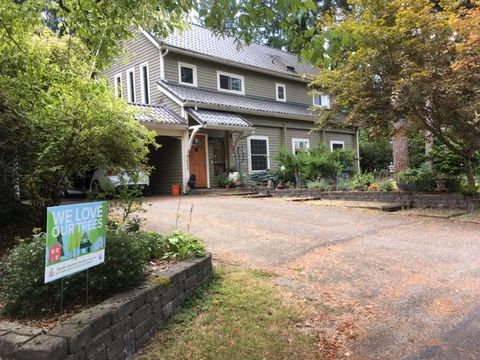
Bellevue is proud to be a "City in a park," with 2,800 acres of parks and open space. The forests in our parks help keep our waters healthy and provide homes for wildlife. It's the trees in our neighborhoods, though, that make this city truly special. Two-thirds of all trees in Bellevue are on residential land.
Bellevue's estimated 1.4 million trees provide health and economic benefits, increase property values and traffic safety, reduce crime, filter out air pollution, limit stormwater runoff and improve water quality. The trees are also essential to the protection of salmon habitat because they provide shade along streams and preserve water quality by preventing erosion. Learn more about what the City is doing to preserve and grow our tree canopy using the links below.
Read our 2021 Tree Canopy Assessment below.
Our Commitment
The City of Bellevue is committed to stewarding the 2,500 acres of forest, playfields and community gardens that make up our parks system, along with the 8,000 acres of tree canopy in the city.
A 2017 assessment found that 37% of the city is covered by tree canopy. In the updated Comprehensive Plan, the city set a target of 40% tree canopy cover, as recommended by leading national experts American Forests. By achieving this goal, we can expand on the health and economic benefits that trees provide.
- Planted over 1,050 trees in city parks and open spaces (2016)
- Actively maintained 15 acres of natural areas each year
- Exceeded target for maintaining 70% of forests in healthy condition (72% of Bellevue forests are in a class 1 or 2 'healthy' state)
- Joined King County's 1 Million Tree Campaign
- Updated the Clearing and Grading code through the NPDES effort to require a permit for the removal of more than five trees over three years
To get involved with tree preservation in Bellevue, check out the many volunteer opportunities in our parks, or plant a tree on your own property using the Tree Care resources found in the tabs above.
Tree Canopy Assessment
Taking Stock of Our Tree Canopy
We have been analyzing our tree canopy using aerial imaging every 5-10 years since 1986. Up-to-date data on tree canopy cover and impervious surfaces allow the city to make informed decisions about tree planting and preservation, stormwater management, land use and the benefits trees provide.
In 2020, the City conducted a Tree Canopy Assessment to show changes in tree canopy cover between 2011 and 2019. The 2019 Assessment found Bellevue's overall tree canopy to be 39%.
In 2023, the City updated our Tree Canopy Assessment for 2021, to assess how our tree canopy cover has changed since 2019 and 2011. The 2021 Assessment found Bellevue's overall tree canopy cover to be 40%, representing growth from 39% in 2019. As of 2021, Bellevue's overall tree canopy has grown by 450 acres since 2011. The full 2021 Tree Canopy Assessment is available below.
Online TreePlotter Canopy Tool
As part of the Tree Canopy Assessment, the City also has access to a new online Tree Canopy Tool, which allows users to analyze tree canopy trends, identify possible planting areas, and check out the tree equity score for their neighborhood. Data for 2021 will be added later this year to the online tool.
Online TreePlotter Canopy Tool
Street Trees
Bellevue's abundance of trees on our streets not only enhance the experience for people walking, biking, and driving through the city, they also provide significant environmental benefits. Bellevue has a comprehensive inventory of its street trees on urban boulevards, which you can check out here:
Tree Care Resources
Your trees do a lot to take care of you, from keeping your air clean to reducing the risk of flooding. Do something in return to keep your neighboring trees healthy! Here is a list of resources on different aspects of tree care. If you are unsure of anything or think your tree might be a hazard, contact an ISA-Certified Arborist for a professional, trustworthy assessment.
Planting a Tree
Planting a new tree is easy to do! There are a few things to make sure you get right to give your tree the best start in life. Check out our video (subtitles will be available in Spanish/Español, Simplified Chinese/简体中文, and Traditional Chinese/繁體中文), illustrated tree planting guide with instructions on tree planting and how to use a tree watering bag or check out the International Society of Arboriculture's (ISA) descriptive guide.
How to Plant a Tree (illustrated guide):
Planting a New Tree (ISA)
Staking
Most newly planted trees do not need to staked and can stand on their own immediately after planting. Staking when not needed can harm your tree by preventing it from building trunk and limb strength, slowing root and trunk development, injuring your tree, or even killing your tree if done improperly.
You should consider staking your tree if your tree is:
- In an area of high wind
- Near vehicle or pedestrian traffic
- Leaning or not growing straight up (use one stake to correct)
- Wobbly after planting (use two stakes)
Stakes should always be removed after 1 to 2 years.
Read more about why and how to properly stake a tree here (borrowed with permission from Seattle's Trees for Neighborhoods Program)
Mulching
Mulch is great for young trees! Mulch helps keep your tree warm in the winter, cool in the summer, helps keep water from evaporating, helps prevent weeds, and provides food for your tree.
Apply a layer of mulch about 3 inches thick all around the base of the tree. Make sure to avoid the base of the truck (the root flare). We recommend keeping mulch about 3 inches (or as wide as your hand) away from the truck to keep your tree healthy.
Read more about the benefits and purposes of mulching your trees from the International Society of Arboriculture (ISA) here.
Pruning
Pruning young trees (starting about 3 or 4 years after you plant) will help your tree grow. Pruning young trees helps shape growth for the rest of your tree's life. This essential care helps trees grow up healthy and can even help prevent limb failure later on. Removing dead wood and properly pruning your tree can encourage better growth, flowering, and fruiting.
You can learn how to prune for yourself from many local organizations, including PlantAmnesty (En Español - PlantAmnesty) City Fruit, Seattle Tilth and Bellevue Botanical Gardens. Make sure you understand the basics of pruning and avoid poor practices like tree topping and liontailing which can permanently harm your tree. If you aren't sure what to do, consider hiring an ISA certified arborist for a professional assessment. If you have financial difficulty or need help finding an arborist, contact PlantAmnesty for assistance.
Read more about pruning basics and its importance from the ISA here.
Note pruning practices for fruit trees are different from other trees. Please don't apply the same practices to your fruit trees as your conifers (or the reverse)!
Water your Tree
Young trees need water to grow and adjust to their new homes in the drier months. You should be giving your young tree water every week. We recommend the use of a tree watering bag, which you can read more about here. You can also make your own using a five-gallon bucket. Learn how here.
Your young tree needs at least 15-20 gallons of water every week in the summer for the first three years! We recommend watering your trees 2-3x more if it is particularly hot or hasn't rained in a while. In years four and five, you can water less often as the tree grows stronger and is better able to survive on its own. After that, all your trees will appreciate occasional watering when it's very hot and dry.
Not sure if you're watering correctly? Soil should be damp at least 2 inches down from the surface.
Other Tree Care
If you are unsure whether a tree is yours or belongs to the city, refer to your property title report or email rightofwayuse@bellevuewa.gov or parksweb@bellevuewa.gov to help determine whether a tree is on public or private property.
For more information about trees, visit the City's Development Services department site.
Tree Canopy Mitigation
Bellevue remains committed to maintaining its "city in a park" character. However, steady development over the last 30 years has resulted in a loss of trees. In 1986, the tree canopy was estimated at 45 percent and by the year 2007, it had declined to 36 percent.
To accommodate growth over the coming decades, Sound Transit is building a light rail line through Bellevue and Puget Sound Energy is upgrading or adding electrical transmission lines. These projects will all result in some loss of tree canopy. The city is requiring mitigation to restore that tree canopy.
East Link Light Rail
To mitigate for the loss of vegetation in Mercer Slough Nature Park where the light rail guideway is being built, Sound Transit has agreed to extensive replanting. The city has worked collaboratively with Sound Transit to minimize to the greatest extent possible impacts to critical areas and their buffers as well as provide visual relief from the light rail facility. Details
Energize Eastside
Puget Sound Energy is applying for permits for this project, which includes the construction of a new substation at Richards Creek and an upgrade of approximately 18 miles of transmission line from Redmond to Renton, through Bellevue. PSE is applying for construction permits. Tree removal and mitigation will be determined as part of the permit review. Details at PSE Energize Eastside.
Lake Hills-Phantom Lake Transmission Line
PSE plans to build a new electrical transmission line between the Lake Hills and Phantom Lake substations. According to PSE, the project will increase overall system reliability and allow for better use of existing facilities for customers in the Lake Hills neighborhood.
The project involves the estimated removal of 295 trees on city-owned property. PSE will plant new trees and install landscaping to restore the impacted areas along the route and mitigate for any impacts to critical areas and/or critical area buffers. The exact number of trees to be replaced is to be determined through clearing and grading and right of way use permits issued by the city.
Per conditional use permit requirements, PSE will contribute $856,740 to the city to compensate for the value of the city-owned trees to be removed. This money will be placed in a fund to help pay for landscape restoration and mitigation materials, including plants and irrigation, required for the project.
Additional Project Information
We Love Our Trees Pledge & Yard Sign
Share Your Commitment to Bellevue's Trees
Show your support for Bellevue's urban forest by signing our We Love Our Trees Pledge and get a free We Love Our Trees yard sign! Take the lead on conservation in your neighborhood. The pledge and signs are available here.
Benefits of Trees
Benefits of Trees
Benefits of Trees
Trees provide a multitude of environmental benefits and enhance the health, economy, and livability of our cities. Trees in Bellevue provide the following benefits:
- Improve air quality
- Prevent erosion and reduce the risk of landslides.
- Absorb CO2 emissions to help combat climate change
- Break down pollutants
- Absorb stormwater to help ensure clean water in our streams and lakes
- Reduce flood risk
- Increase property values
- Support public health and wellbeing
- Enhance neighborhood character
Tree Identification
Have you always wondered what a certain tree was? Maybe you saw it along the sidewalk downtown, with fan-shaped leaves that turn a brilliant yellow in October. Or maybe it was along a trail, with deep green boughs and soft red bark.
Now you can find out using our Bellevue Tree Guide! Every trip to a park is better when you know what you're looking at.

